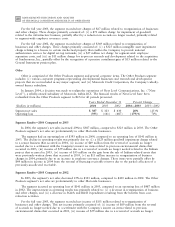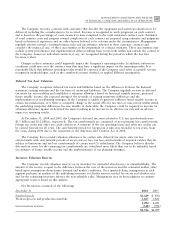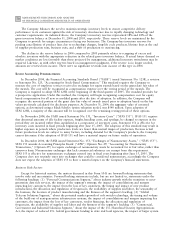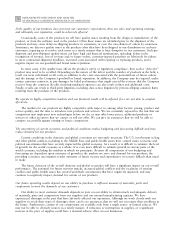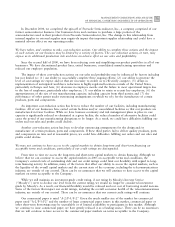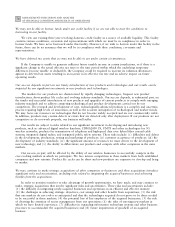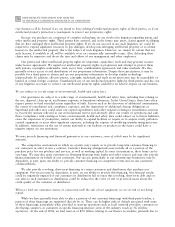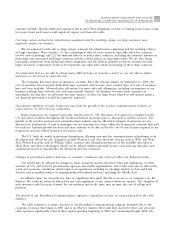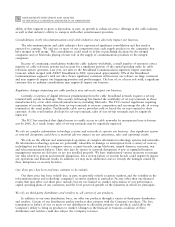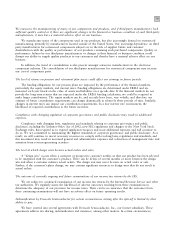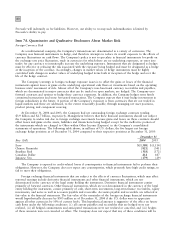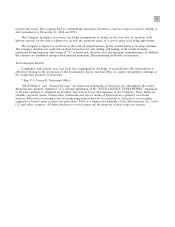Motorola 2004 Annual Report Download - page 82
Download and view the complete annual report
Please find page 82 of the 2004 Motorola annual report below. You can navigate through the pages in the report by either clicking on the pages listed below, or by using the keyword search tool below to find specific information within the annual report.
74 MANAGEMENT'S DISCUSSION AND ANALYSIS
OF FINANCIAL CONDITION AND RESULTS OF OPERATIONS
We may not be able to borrow funds under our credit facility if we are not able to meet the conditions to
borrowing in our facility.
We view our existing three-year revolving domestic credit facility as a source of available liquidity. This facility
contains various conditions, covenants and representations with which we must be in compliance in order to
borrow funds. We have never borrowed under this facility. However, if we wish to borrow under this facility in the
future, there can be no assurance that we will be in compliance with these conditions, covenants and
representations.
We have deferred tax assets that we may not be able to use under certain circumstances.
If the Company is unable to generate suÇcient future taxable income in certain jurisdictions, or if there is a
signiÑcant change in the actual eÅective tax rates or the time period within which the underlying temporary
diÅerences become taxable or deductible, the Company could be required to increase its valuation allowances
against its deferred tax assets resulting in an increase in its eÅective tax rate and an adverse impact on future
operating results.
Our success depends in part on our timely introduction of new products and technologies and our results can be
impacted by our signiÑcant investments in new products and technologies.
The markets for our products are characterized by rapidly changing technologies, frequent new product
introductions, short product life cycles and evolving industry standards. Our success depends, in substantial part, on
the timely and successful introduction of new products and upgrades of current products to comply with emerging
industry standards and to address competing technological and product developments carried out by our
competitors. The research and development of new, technologically-advanced products is a complex and uncertain
process requiring high levels of innovation, as well as the accurate anticipation of technological and market trends.
We may focus our resources on technologies that do not become widely accepted and are not commercially viable.
In addition, products may contain defects or errors that are detected only after deployment. If our products are not
competitive or do not work properly, our business will suÅer.
Our results are subject to risks related to our signiÑcant investment in developing and introducing new
products, such as: advanced digital wireless handsets; CDMA2000 1X, UMTS and other technologies for 3G
wireless networks; products for transmission of telephony and high-speed data over hybrid Ñber coaxial cable
systems; integrated digital radios; and integrated public safety systems. These risks include: (i) diÇculties and delays
in the development, production, testing and marketing of products; (ii) customer acceptance of products; (iii) the
development of industry standards; (iv) the signiÑcant amount of resources we must devote to the development of
new technology; and (v) the ability to diÅerentiate our products and compete with other companies in the same
markets.
Our success, in part, will be aÅected by the ability of our wireless businesses to successfully compete in the
ever-evolving markets in which we participate. We face intense competition in these markets from both established
companies and new entrants. Product life cycles can be short and new products are expensive to develop and bring
to market.
We may continue to make strategic acquisitions of other companies or businesses and these acquisitions introduce
signiÑcant risks and uncertainties, including risks related to integrating the acquired businesses and achieving
beneÑts from the acquisitions.
In order to position ourselves to take advantage of growth opportunities, we have made, and may continue to
make, strategic acquisitions that involve signiÑcant risks and uncertainties. These risks and uncertainties include:
(1) the diÇculty in integrating newly-acquired businesses and operations in an eÇcient and eÅective manner;
(2) the challenges in achieving strategic objectives, cost savings and other beneÑts from acquisitions; (3) the risk
that our markets do not evolve as anticipated and that the technologies acquired do not prove to be those needed
to be successful in those markets; (4) the potential loss of key employees of the acquired businesses; (5) the risk
of diverting the attention of senior management from our operations; (6) the risks of entering new markets in
which we have limited experience; (7) diÇculties in expanding information technology systems and other business
processes to accommodate the acquired businesses; and (8) future impairments of goodwill of an acquired
business.


